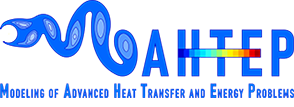Development of computational models of boiling heat transfer in gyrotron cavities
Activity carried out in the framework of Andrea Allio's PhD (tutored by Prof. Laura Savoldi) in collaboration with MuSyChEn Group @ PoliTO.
Objective of the activity: Development of an advanced numerical model applicable to the study of conjugate heat transfer involving boiling phenomena at the interface between the heated surface and the cooling fluid for gyrotron cavities and SC power cables cooling.
Framework of the activity:
Several engineering applications in the energy field, among which the cooling of electronic devices such as the gyrotrons, needed to inject radio-frequency heating in the magnetic confinement devices for fusion applications, or the super-conducting (SC) cables for AC or DC power transmission, are at a crossroads. Heat removal in the gyrotron cavity involves subcooled water at room temperature as well as coolant to remove heat fluxes up to 20-25 MW/m2, which can reach boiling conditions as it is stuck in a complex irregular porous matrix constituted by Raschig Rings. The SC cables for power transmission, subject to loads in the order of few W/m, are cooled by weakly subcooled liquid nitrogen, which is under the risk of boiling due to the length (in the order of several tens of km) of cables. Moreover, friction losses can reduce the pressure under the critical value for phase transition. The potential role of boiling to enhance heat transfer is considered in any situation, but the rule-of-thumb for the operation is to keep temperature as far as possible from the boiling onset. The point is that, while CFD models are available for single-phase conditions, the numerical modeling of boiling, and forecast of boiling onset, is often considered unreliable.

Figure 1. Gyrotron cavity cooling system based of Raschig Rings with detail of the temperature in the solid material (left) and in the fluid inside the Raschig Rings matrix (right).
The complexity of the nature of CFD multiphase models is related to the fact that part of the model equations and parameters have been developed through theoretical and/or experimental analyses performed in particularly restricted conditions, so the applicability of a model in a different specific case is generally challenging and the reliability not granted.
The figure below represents the gyrotron cavity cooling system based of Raschig Rings, with details of the temperature in the solid material (on the upper left) and in the fluid inside the Raschig Rings matrix (on the lower right).
Planned activity:
The first step of the activity consists of an extensive study of strategies and tools used in the modelling of phase change phenomena. The CFD tool to be used for the planned work is to be identified, and the most suitable formulations for the closure relations of the interfacial forces, the phase change treatment at the liquid-vapour interface and the energy transfer at the fluid-solid interface, relevant to the two-phase flows considered here, will be implemented. The performance and the results of the models will be compared with test cases available in published literature, in conditions as relevant as possible to those encountered in the two case studies of interest.
The model will be applied to the two cases: cooling of gyrotron cavities and cooling of high temperature superconductor cables used for power transmission. During this phase, experimental tests will be important to acquire relevant data for model validation.
If the validation process will return reliable results, the final objective will be the study of possible engineering solutions that could take advantage of boiling to enhance heat removal, instead of avoiding it.

MUlti-physiCs simulation of the gyrotron CAvity with the MUCCA tool
Activity carried out by Andrea Allio, Rosa Difonzo and Laura Savoldi in collaboration with EPFL, EUROfusion, Fusion For Energy, KIT, Thales.
Objective of the activity: Analyze and increase the performance of the European Gyrotron cavities.
Framework of the activity:
The actual cooling systems of the W7-X Gyrotrons and the ITER European Gyrotrons prototype, based on the Thales-patented Raschig Rings (RR) technology, need to be optimized to further increase the device performance. The analysis can be performed self-consistently using the ad-hoc developed MUCCA tool for the MUlti-physiCs simulation of the gyrotron CAvity.
Publications:
- S. Stanculovic, R. Difonzo, A. Allio, K. A. Avramidis, P. Bruecker, G. Gantenbein, S. Illy, J. Jelonnek, P. C. Kalaria, M. Misko, T. Rzesnicki, L. Savoldi, "Calibration of the KIT test setup for the cooling tests of a gyrotron cavity full-size mock-up equipped with mini-channels", Fusion Engineering and Design, vol. 172, 112744, 2021.
- A. Bertinetti, F. Albajar, K. A. Avramidis, F. Cau, F. Cismondi, G. Gantenbein, J. Jelonnek, P. C. Kalaria, S. Ruess, T. Rzesnicki, L. Savoldi, R. Zanino, "Analysis of an actively-cooled coaxial cavity in a 170 GHz 2 MW gyrotron using the multi-physics computational tool MUCCA", Fusion Engineering and Design, vol. 146, Part A, pp. 74-77, 2019.
- A. Bertinetti, F. Albajar, F. Cau, A. Leggieri, F. Legrand, E. Etienne, G. Ritz, L. Savoldi, R. Zanino, A. Zappatore, "Design, Test and Analysis of a Gyrotron Cavity Mock-Up Cooled Using Mini Channels", IEEE Transactions on Plasma Science, vol. 46, n. 6, pp. 2207 - 2215, 2018.
- K. Avramidis, A. Bertinetti, F. Albajar, Ferran, F. Cau, F. Cismondi, G. Gantenbein, S. Illy, Z. C. Ioannidis, J. Jelonnek, F. Legrand, I. G. R. Pagonakis, Y. Rozier, T. Rzesnicki, L. Savoldi, M. Thumm, R. Zanino, "Numerical Studies on the Influence of Cavity Thermal Expansion on the Performance of a High-Power Gyrotron", IEEE Transactions on Plasma Science, vol. 65, n. 6, pp. 2308 - 2315, 2018
- A. Bertinetti, K. A. Avramidis, F. Albajar, F. Cau, F. Cismondi, Y. Rozier, L. Savoldi, R. Zanino, "Multi-physics analysis of a 1MW gyrotron cavity cooled by mini-channels", Fusion Engineering and Design, vol. 123, pp. 313-316, 2017.

